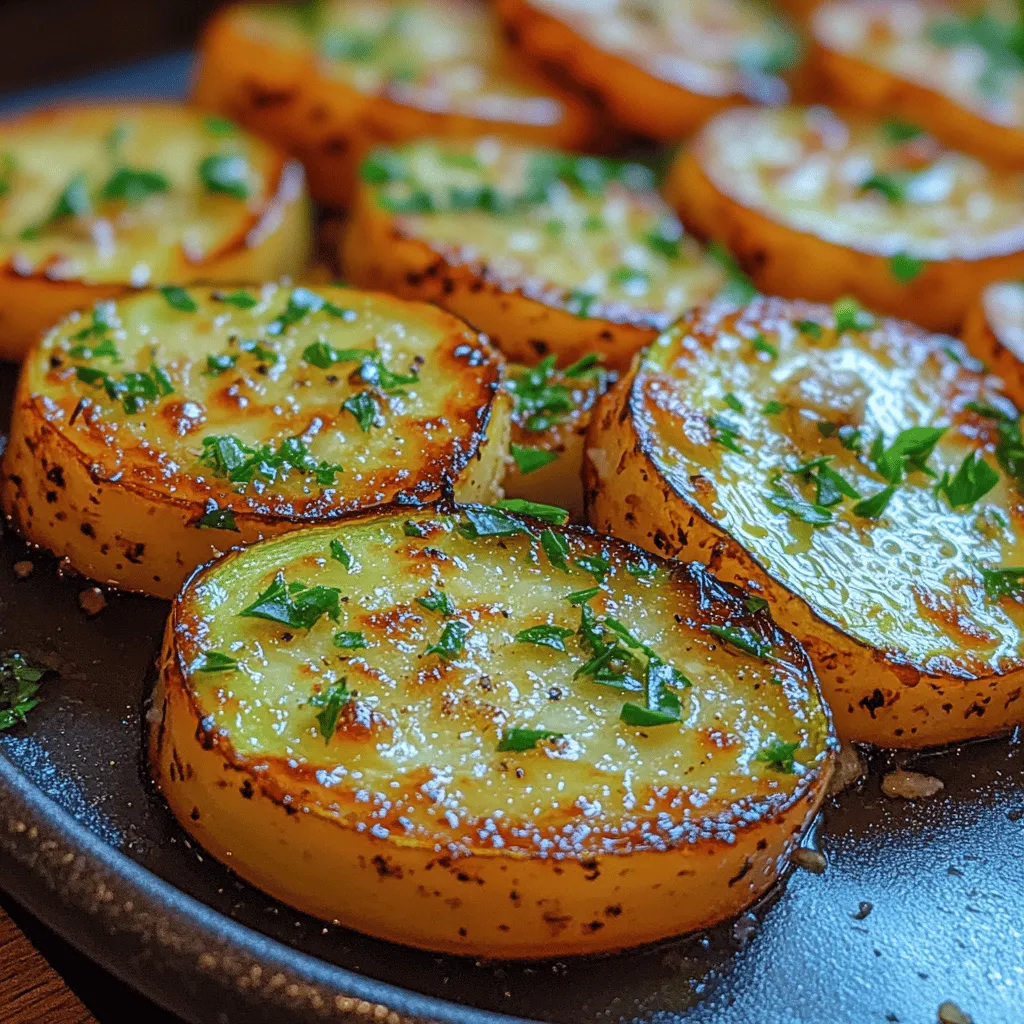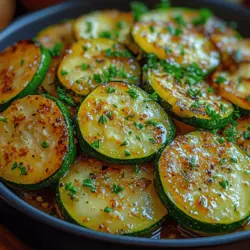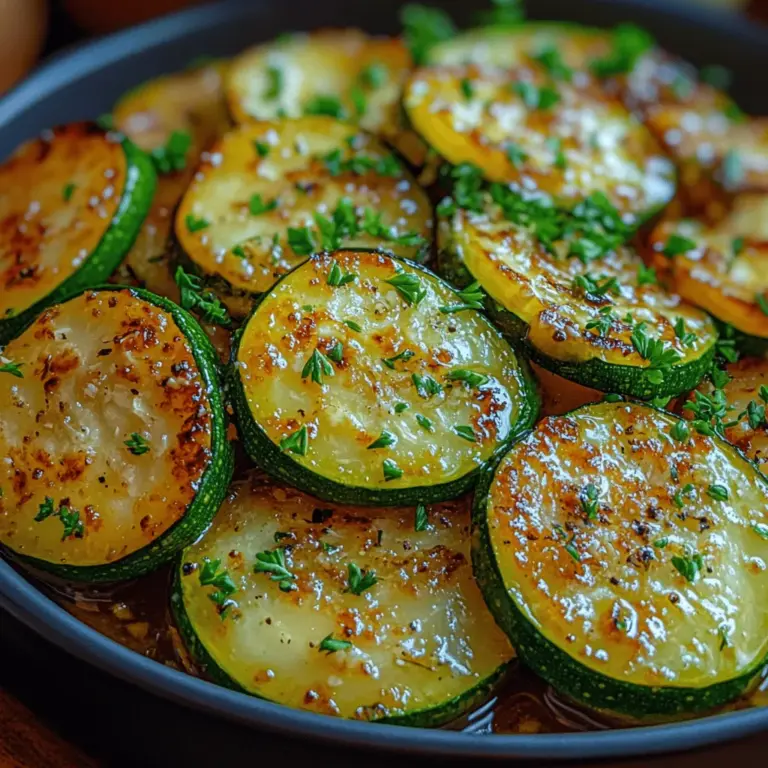Introduction
Savory Garlic Herb Sautéed Zucchini is a delightful dish that exemplifies the beauty of simple, fresh ingredients. Whether you are an experienced cook or a novice in the kitchen, this recipe offers a quick and easy way to prepare a flavorful side dish that can enhance any meal. The combination of tender zucchini sautéed with aromatic garlic and fresh herbs creates a taste experience that is both satisfying and nutritious.
This dish is particularly appealing because it showcases zucchini, a versatile vegetable that can be enjoyed in numerous ways. It can be served alongside grilled proteins, tossed into pasta, or even enjoyed on its own for a light and healthy meal. The vibrant flavors and textures of sautéed zucchini make it a wonderful addition to your culinary repertoire, whether you’re hosting a dinner party or simply looking to elevate your weeknight dinner.
As with any dish, the freshness of your ingredients plays a crucial role in the final outcome. Using fresh zucchini, high-quality extra-virgin olive oil, and aromatic herbs can make all the difference in flavor and nutritional value. With the right ingredients and a few simple steps, you can whip up a delicious Savory Garlic Herb Sautéed Zucchini that will impress family and friends alike.
Understanding Zucchini: A Nutritional Powerhouse
Zucchini is not just a versatile vegetable; it is also a nutritional powerhouse that offers numerous health benefits. Low in calories yet high in essential nutrients, zucchini is an ideal choice for anyone looking to maintain a healthy diet. A single medium-sized zucchini contains only about 33 calories, making it a guilt-free option for those watching their caloric intake.
One of the standout features of zucchini is its high fiber content. Fiber is essential for maintaining good digestive health and can help keep you feeling full longer. A serving of zucchini provides about 2 grams of dietary fiber, contributing to your daily fiber intake and promoting overall gut health.
In addition to being low in calories and high in fiber, zucchini is rich in several vitamins and minerals. It is an excellent source of vitamin C, which plays a crucial role in immune function and skin health. Zucchini also contains vitamins A and K, both of which are important for maintaining healthy vision, skin, and blood clotting. Furthermore, zucchini is packed with antioxidants, which help combat oxidative stress and inflammation in the body.
Incorporating zucchini into your diet can be a delicious way to boost your nutrient intake. Whether roasted, grilled, or sautéed, zucchini retains its health benefits while providing a satisfying texture and flavor.
Essential Ingredients for Savory Garlic Herb Sautéed Zucchini
To create a magnificent Savory Garlic Herb Sautéed Zucchini, you will need a short list of essential ingredients, each contributing to the dish’s overall flavor and nutritional value.
Zucchini: Types and Selection Tips
When selecting zucchini for this recipe, opt for firm, young zucchinis that are free of blemishes or soft spots. The most common variety is the dark green zucchini, but you may also encounter yellow zucchini, which offers a slightly sweeter flavor. Choose zucchinis that are about 6 to 8 inches long for the best texture and taste. Smaller zucchinis tend to be more tender and flavorful, while larger ones may have a tougher skin and larger seeds.
Extra-Virgin Olive Oil: Health Benefits and Flavor Profile
Extra-virgin olive oil is a staple in Mediterranean cuisine and an essential ingredient in this sautéed zucchini recipe. Rich in healthy monounsaturated fats, extra-virgin olive oil has been linked to several health benefits, including reducing inflammation and lowering the risk of chronic diseases. Its robust flavor enhances the dish while also helping to sauté the vegetables evenly.
When choosing olive oil, look for high-quality extra-virgin options, which are cold-pressed from the first extraction of olives. This process preserves the oil’s natural flavors and nutrients, ensuring a vibrant taste in your cooking.
Garlic: Nutritional Benefits and Culinary Uses
Garlic is a key ingredient that adds depth and richness to your sautéed zucchini. Not only does it provide a robust flavor profile, but garlic is also known for its numerous health benefits. It contains allicin, a compound with potent anti-inflammatory and antioxidant properties. Garlic has been linked to improved cardiovascular health, better immune function, and even potential cancer-fighting properties.
When preparing this dish, fresh garlic is preferable to pre-minced varieties, as it offers a more vibrant flavor. The key is to mince the garlic finely to ensure it cooks evenly and releases its aromatic qualities into the dish.
Fresh Herbs: Importance of Using Fresh Versus Dried
Fresh herbs are essential to elevating the flavor of Savory Garlic Herb Sautéed Zucchini. Common choices include basil, parsley, or thyme, each adding its unique aroma and taste. Fresh herbs pack a more potent flavor than their dried counterparts and contribute a burst of freshness to the dish.
When selecting fresh herbs, look for bright green leaves free of wilting or browning. To prepare, simply chop the herbs coarsely before adding them to the sautéed zucchini for maximum flavor impact.
Seasoning: The Role of Salt and Pepper in Enhancing Flavor
Salt and pepper are fundamental seasonings that help enhance the natural flavors of your ingredients. Salt draws out moisture from vegetables, intensifying their taste, while pepper adds a subtle heat that balances the dish. A pinch of both is essential for creating a well-rounded flavor profile in your sautéed zucchini.
Lemon: Brightening the Dish with Acidity
Adding a splash of lemon juice at the end of cooking can brighten the dish and elevate its flavors. The acidity of lemon juice cuts through the richness of the olive oil and complements the garlic, providing a refreshing contrast. Fresh lemon juice is always recommended for the best flavor, but bottled lemon juice can work in a pinch.
Parmesan Cheese: Optional but Impactful Flavor Enhancer
While not necessary, grated Parmesan cheese can add a rich umami flavor to Savory Garlic Herb Sautéed Zucchini. The nutty and salty characteristics of Parmesan complement the dish beautifully, making it even more satisfying. If you’re looking to keep the dish dairy-free, feel free to skip this ingredient or use a dairy-free alternative.
Step-by-Step Guide to Preparing Savory Garlic Herb Sautéed Zucchini
Now that we’ve covered the essential ingredients, let’s dive into the step-by-step guide for preparing Savory Garlic Herb Sautéed Zucchini. Proper preparation is crucial to achieving the best texture and flavor in this dish.
Preparing the Ingredients
Before you start cooking, it’s important to prepare your ingredients. Begin by washing the zucchini under cold water to remove any dirt or residue. Pat them dry with a clean towel. For the best results, slice the zucchini into uniform half-moons or rounds—about ¼ inch thick—ensuring that they cook evenly.
Next, move on to the garlic. Peel the cloves and use a knife to mince them finely. The finer the garlic, the more flavor will be released during cooking. If you’re using fresh herbs, rinse them under cold water and pat them dry. Chop them coarsely and set them aside for later use.
Importance of Preparation in Cooking
Preparation is a vital step in cooking, especially when it comes to sautéing. Having all your ingredients prepped and ready to go allows for a smoother cooking process, preventing overcooking or burning of any components. It also enables you to focus on the cooking technique itself, ensuring that each ingredient shines in the final dish.
Heating the Oil
Once your ingredients are prepped, it’s time to heat the oil. In a large skillet, pour in about two tablespoons of extra-virgin olive oil. Place the skillet over medium heat and allow the oil to warm up for a minute or so. To test if the oil is hot enough, you can add a small piece of zucchini; if it sizzles, the oil is ready.
Explanation of Oil Temperature and Its Impact on Cooking
The temperature of the oil is crucial for achieving a perfect sauté. If the oil is too cool, the zucchini will absorb it and become soggy instead of sautéed to perfection. Conversely, if the oil is too hot, it can burn the garlic and create an unpleasant bitter taste. A medium heat allows for even cooking, ensuring that the zucchini becomes tender and golden without compromising the flavors.
Sautéing the Garlic
Once the oil is heated, it’s time to add the minced garlic to the skillet. Sauté the garlic for about 30 seconds, stirring continuously to prevent it from burning. The goal is to release the aromatic compounds without letting the garlic turn brown, as burnt garlic can impart a bitter flavor to the dish.
Garlic should be fragrant and slightly golden when it’s ready for the next step. Once the garlic is perfectly sautéed, add your sliced zucchini to the skillet, stirring to coat the pieces in the garlicky oil. Continue cooking, stirring occasionally, until the zucchini is tender yet still retains a slight crunch, usually about 5 to 7 minutes.
As you sauté, keep an eye on the zucchini’s color and texture. The goal is to achieve a vibrant green color while allowing the natural sweetness of the zucchini to shine through.

How Sautéing Garlic Enhances Flavor
Sautéing garlic is a culinary technique that not only infuses dishes with a rich, aromatic flavor but also adds depth and warmth to the overall profile of your meal. When garlic is cooked, its natural sugars caramelize, producing a sweet and savory taste that is irresistible. The key to successfully sautéing garlic lies in timing; it should be cooked until fragrant but not browned, as burnt garlic can impart a bitter flavor. As you begin to sauté garlic for your Savory Garlic Herb Sautéed Zucchini, keep a close eye on it to ensure it reaches that perfect golden hue without overcooking.
Cooking the Zucchini
Once your garlic is fragrant, it’s time to add the zucchini. Cut the zucchini into even slices or half-moons to ensure uniform cooking. This is crucial because uneven pieces can lead to some being overcooked while others remain crunchy. Add the zucchini to the pan and sauté over medium-high heat, allowing it to cook without overcrowding the pan, which can lead to steaming rather than sautéing. Stir occasionally to promote even cooking, taking care not to let it brown too much; a tender yet slightly crisp texture is what you’re aiming for.
Best Practices for Sautéing
To achieve the best results when sautéing zucchini, adhere to these best practices:
1. Preheat Your Pan: Always preheat your skillet before adding oil. This ensures a good sear and prevents the zucchini from absorbing too much oil.
2. Use the Right Oil: Olive oil is a popular choice due to its flavor and health benefits, but you can also experiment with avocado oil for a higher smoke point.
3. Don’t Overcrowd the Pan: If you have a lot of zucchini to cook, work in batches. Overcrowding can lower the temperature of the pan, leading to steaming instead of sautéing.
4. Adjust Heat as Needed: If you notice the garlic beginning to brown too quickly, lower the heat. The goal is to sauté, not fry.
Maintaining Texture and Flavor Through Timing
Timing is everything when it comes to sautéing zucchini. Typically, zucchini takes about 4-5 minutes to become tender while still retaining a slight crunch. Keep stirring gently to prevent sticking, and monitor closely to ensure that it cooks evenly. The goal is to achieve a vibrant green color and a tender texture without losing the vegetable’s inherent crispness. If you prefer a softer zucchini, add an extra minute or two to the cooking time, but be careful not to overdo it.
Seasoning with Herbs and Spices
Herbs and spices are essential for enhancing the flavor complexity of your Savory Garlic Herb Sautéed Zucchini. Fresh herbs such as basil, thyme, and oregano can elevate the dish, providing aromatic notes that complement the garlic and zucchini beautifully. Add herbs towards the end of cooking to preserve their freshness and flavor.
How Herbs Contribute to Flavor Complexity
Herbs not only add flavor but also contribute to the overall aroma and visual appeal of the dish. For example, fresh basil imparts a sweet, slightly peppery flavor, while thyme adds an earthy note. Mixing different herbs can create a well-rounded dish that tantalizes the palate. Experimenting with dried herbs is also an option; just remember that dried herbs are more concentrated, so you’ll need less than fresh.
Balancing Flavors with Salt and Pepper
Seasoning is crucial in bringing out the natural flavors of your ingredients. A pinch of salt enhances the sweetness of the zucchini and the richness of the garlic, while freshly cracked black pepper adds a gentle heat. Be sure to taste as you go, adjusting seasoning according to your preference. Remember that salt can draw out moisture, so it’s best to add it a little at a time, allowing the flavors to develop fully.
Finishing Touches: Lemon and Parmesan
After sautéing your zucchini to perfection, you can take the dish to the next level with finishing touches such as a squeeze of fresh lemon juice and a sprinkle of Parmesan cheese.
The Significance of Acidity in Dishes
Adding lemon juice provides a burst of acidity that brightens the dish, cutting through the richness of the sautéed garlic and enhancing the overall flavor. Acidity is an essential component in cooking, balancing flavors and adding freshness. Just a teaspoon or two can make a significant difference, elevating your sautéed zucchini from good to exceptional.
How Parmesan Can Elevate the Dish
Parmesan cheese not only adds a savory umami flavor but also a creamy texture that complements the vegetables. The saltiness of the cheese enhances the dish, making it feel more indulgent without being overly heavy. For a dairy-free option, consider nutritional yeast, which offers a similar umami flavor with a hint of nuttiness.
Serving Suggestions
When it comes to serving your Savory Garlic Herb Sautéed Zucchini, there are countless options to consider.
Ideas for Pairing with Grains, Proteins, or Salads
This dish pairs beautifully with a variety of grains, such as quinoa or brown rice, providing a hearty and nutritious meal. If you prefer proteins, consider serving it alongside grilled chicken, shrimp, or tofu for a satisfying dish. For a lighter option, it can be served on a bed of mixed greens, creating a refreshing salad.
Presentation Tips for an Appealing Dish
Presentation plays a key role in the dining experience. To make your dish visually appealing, consider using a large serving platter. Layer the sautéed zucchini and drizzle with lemon juice, followed by a sprinkle of freshly grated Parmesan. Garnish with additional herbs for a pop of color and freshness.
Suggestions for Meal Prep and Storage
Savory Garlic Herb Sautéed Zucchini is an excellent candidate for meal prep. It can be stored in an airtight container in the refrigerator for up to three days. To reheat, simply sauté in a pan for a few minutes until warmed through. This makes it a convenient side dish for weeknight dinners or a tasty addition to lunch boxes.
Exploring Variations of Sautéed Zucchini
One of the best aspects of sautéed zucchini is its versatility. Here are a few ideas to customize your dish further:
Additional Ingredients to Consider
Feel free to add other vegetables to the mix, such as bell peppers, cherry tomatoes, or mushrooms, which can enhance both flavor and nutrition. For a heartier option, consider incorporating cooked grains like farro or barley.
Other Vegetables that Complement Zucchini
Zucchini pairs well with a variety of vegetables, including yellow squash, asparagus, and bell peppers. Mixing different vegetables not only adds color but also a range of textures and flavors.
Different Herbs and Spices for Customization
You can easily switch up the herbs and spices based on what you have on hand. Try adding a pinch of red pepper flakes for heat or swapping basil for dill for a different flavor profile. Experimentation is key to discovering new favorites.
Suggestions for Dietary Adaptations (Vegan, Gluten-Free)
This dish is naturally gluten-free and can be adapted for various dietary needs. To make it vegan, simply omit the Parmesan cheese or replace it with a vegan alternative. You can also add plant-based proteins, such as chickpeas, to create a more filling meal.
The Culinary Journey of Sautéed Zucchini
Zucchini has a rich history in global cuisine, dating back to ancient civilizations. Originally cultivated in Mesoamerica, zucchini made its way to Europe in the 19th century, where it became a staple in Mediterranean cooking.
Historical Context of Zucchini in Cuisine
Zucchini is a summer squash that thrives in warm climates, making it a popular ingredient in summer dishes. Its mild flavor allows it to be utilized in various preparations, from sautéing and grilling to baking and stuffing.
Regional Variations and Cultural Significance
In Italian cuisine, zucchini is often featured in ratatouille, a dish that highlights the flavors of summer vegetables. In contrast, in Middle Eastern cuisine, zucchini is frequently stuffed with rice and spices, showcasing its adaptability across cultures.
The Evolution of Sautéed Zucchini Recipes
Over time, sautéed zucchini recipes have evolved, reflecting changing culinary trends and preferences. Today, it is celebrated for its health benefits, versatility, and ease of preparation, making it a favorite among home cooks and professional chefs alike.
Conclusion
Savory Garlic Herb Sautéed Zucchini is not only a delicious side dish but also a versatile addition to your culinary repertoire. Its simplicity and health benefits make it a great choice for any meal. By experimenting with different ingredients and flavors, you can create a dish that resonates with your personal taste. Whether served alone or paired with grains, proteins, or salads, this zucchini recipe is sure to impress. Embrace the opportunity to make this dish your own and savor the delightful flavors that sautéed zucchini brings to the table.

